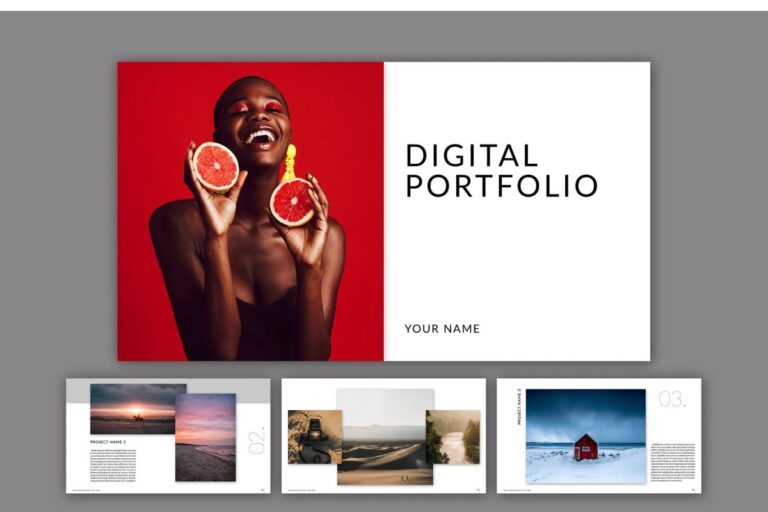A digital portfolio can give insight into your career path as you apply for jobs, network with others, or attract new clients and freelancing opportunities. It can serve as evidence of your knowledge and skills in the industry and highlight your achievements throughout your career. Learning how to create a digital portfolio can help you differentiate yourself from competing candidates and improve your chances of attaining your career goals.
What is a digital portfolio?
A digital portfolio is a collection of examples of your work that are accessible online. You typically only include your best work in your portfolio so you can showcase your professional skills, technical prowess, and creativity. Digital portfolios can consist of many different types of content, such as:
- Photographs
- Text
- Illustrations
- Technical drawings
- Spreadsheets
- Plans
- webpages
- Entertainment
- Paint
Along with samples of your work, you can also include a brief description of yourself, where you can introduce yourself to the reader, discuss your interests, and upload a photo. An online portfolio allows you to access and share past project mockups easily.
Including a portfolio in an application allows you to convey proof of your skills to hiring managers. A visual representation of your experiences also helps employers decide if you are the right candidate for their company and position.
How to make a digital portfolio
Follow these steps to make a stunning digital portfolio:
Understand your audience
Creating content for an audience helps you think about what your audience might want. Since the target audience for a digital portfolio can include hiring managers, clients, and individuals in your industry, consider what types of content they might be looking for.
For example, if you are looking for work as an architect, consider including samples of architectural drawings and images from past projects.
If you’re researching a potential client as a freelance copywriter, you can incorporate samples from previous campaigns you’ve worked on that resemble the prospect’s brand into your online portfolio.
Tell a story
One of the best ways to engage your audience is to tell a story. In your online portfolio, explain why you chose this career path, detail your professional experiences, and provide insight into your daily life. Consider creating a distinct section dedicated to your bio, skills, and career goals, such as an “About Me” section.
You can connect emotionally with the reader by including relevant information about yourself. Suppose you reach out to a potential mentor or professional reference. In that case, they may appreciate hearing about your professional development so they feel more confident speaking positively about you to other interested parties.
Make sure your bio reflects audience interest. For example, you can describe your passion for your industry and commitment to quality work as a candidate.
Could you keep it simple?
Creating a visually appealing portfolio can promote engagement and excitement when people review your content. It can also convey thoughtfulness and professionalism. When choosing the layout, font, and illustrations for your portfolio.
Keep the design clean, consistent, and uncluttered, so your message and intentions remain clear. Limit the amount of text describing your work to keep the reader focused on the actual samples.
Use categories
To simplify your portfolio, include categories in a navigation menu that demonstrate your range of experiences. For example, suppose you are a freelance writer who has covered various topics, such as parenting, career counseling, health, and community development. In that case, you can create sections in your digital portfolio for each topic.
Alternatively, photographers specializing in different styles can create lifestyle, wedding, and family categories in their portfolios. Separating your content into more manageable sections directs users to the information they seek.
Highlight your most impressive work.
When you’re ready to add samples, include only the material demonstrating your most impressive skills. Instead of including every piece of content you’ve created, focus on showcasing projects you’re proud of. For example, you might display snippets of successful marketing campaigns for a marketing feature.
You can also include pieces that have received praise from others. For example, if you own a business, you may consist of past work that received positive customer feedback. If you won an award for your work, write it down with a short title describing the award and the date you received it.
Tips for making a digital portfolio

Once you’ve finished adding content to your digital portfolio, consider the following tips to improve the collection:
Pay attention to search engine optimization
To increase the chances of people concluding your portfolio online, take steps to help students find your mooring page. Ensure your portfolio is HTML-based, making it easy to view from other devices, and use industry-relevant keywords in the content and corresponding URL.
You can also write a unique meta description that tells people what to expect from your portfolio when they click on the search engine results page.
Include links to social media.
Social media is an essential part of today’s society, so it’s a good idea to include a widget that links your portfolio to your professional social media accounts. This makes it easier for people to share their information with others, increasing their visibility. You can also allow people to contact you to learn more about your services.
For example, in a photography portfolio, you can direct readers to your social media page showcasing your work and how you interact positively with your clients. People who review your portfolio may appreciate your commitment to maintaining an active online presence that reflects positively on you and your career.
Update your portfolio frequently.
People who constantly create new content may forget to upload new work to their digital portfolio. Set a monthly reminder to update your site with new work and consider phasing out old, outdated content. This can show that you are up to date with the latest industry trends.
You will also be able to demonstrate that you have recent professional experience. For example, suppose you show samples of software he designed two months ago. In that case, a hiring manager may discover that he is familiar with technological advances and has grown professionally while diversifying his skills.
Add customer reviews
Nowadays, people often spend a lot of time researching before purchasing a product or hiring professional services. That’s why including positive customer reviews in your portfolio is essential.
This helps build trust and credibility, especially with people who have never met you. Consider creating a testimonials section that includes direct quotes that customers may have left on social media, emails, and blog posts.
Who uses a digital portfolio?

Students and employees in various industries use digital portfolios to demonstrate their artistic skills and showcase their work online. Almost anyone can use a digital portfolio to showcase their qualifications through images, but here are some of the most common people who use this tool:
- Writers
- Photographers
- Graphic designers
- Illustrators
- Marketers
- Architects
- Teachers
- makeup artists
- Developers
- Models
- Cameramen
Components of a digital portfolio
Below are some typical elements you can include in a digital portfolio:
Originality Statement: It is good practice to have a short paragraph stating that the content in your digital portfolio is original, confidential, and yours. This statement can specify parts of the wallet that others cannot copy.
Professional biography: Include a brief description of what you do, specifying the services you provide or your areas of specialization. You can organize this information in your “About Me” section.
Career goals: You can also be obliged to write a summary of your career goals to show employers your ambition and give them an idea of your future vision.
Resume: Include a link to your resume in your digital portfolio. This way, if a potential employer, recruiter, or client finds your portfolio online, they can access your CV.
Contact Information: If you want potential employers or clients to be able to contact you with any questions, be sure to include your contact information in an easy-to-find place. Enter a phone number and email address.
Relevant Skills: Another item you can include in your “About Me” section is a list of your most essential industry skills. For example, if you work in graphic design, you could talk about your creativity, attention to detail, and computer skills.
Work Samples: Your work samples demonstrate the skills listed on your resume in the “About Me” section or elsewhere in your portfolio. These samples may be photographs, works of art, articles, advertising models, and any other visual or written content.


